|
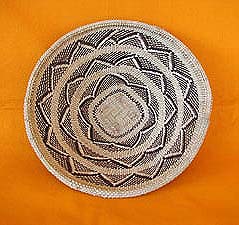 African Baskets
from Zimbabwe African Baskets
from Zimbabwe
By Guy Lynn
Having been born in Africa, I was
well aware of the beautiful hand woven grass baskets that come
from Africa. I have always had baskets in my life as either wall
decorations or as a bowl to hold fruit or bread on the dining
room table. It was just a part of my life. My Grandmother had
them, my mother and older sister used them, and my wife and I
have them scattered around the house and also as customer shopping
baskets when we do trunk shows or trade shows selling our beads.
They are just a part of our everyday lives.
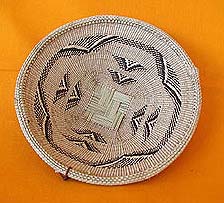 What
I didn’t realize until now was just how beautiful and timeless
they are. Like most things in life, we take them for granted
until they go away. What
I didn’t realize until now was just how beautiful and timeless
they are. Like most things in life, we take them for granted
until they go away.
African artifacts have emerged for
centuries as some of the most beautiful artistic expressions
of mankinds skill using their hands and whatever raw materials
they have in their possession. You can track totally different
generations and cultures by the artifacts they produce and the
materials they use or have access to. When I was a young boy
and then man in Rhodesia, in the sixties and seventies, the woven
baskets were totally different in style and artistic expression
than they are now. They were made better back then. (I’ve
never heard that statement before!) The baskets that the native
tribesmen used in the bush were functional, tightly woven and
without decoration, watertight, because the women had to walk
up to 20 miles round trip to collect water for cooking, and had
to last for years under harsh conditions. Now the baskets are
only made for the tourist trade, and are intricately decorated
with dyed grasses and beads and not watertight or virtually indestructible.
They are beautiful, make no mistake, and are well made.
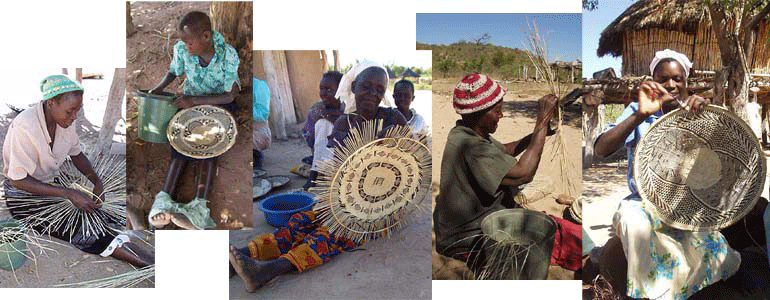
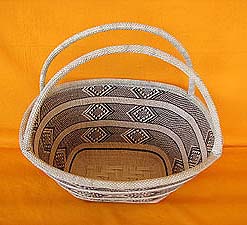
Most African countries produce hand
woven grass or straw baskets, as the raw material is easy to
obtain and inexpensive. The skill is passed down from mother
to daughter, and is a social event at the kraals and villages
in every area where baskets are made, as the women sit around
and weave their baskets all day long, trading gossip and news
while they work. Every area or district has its own style, and
the different weavers compete with each other on patterns and
shapes. However, copying of successful patterns and shapes is
rampant, which is why a certain area or region becomes known
for its style, as every weaver adopts that style as their own.
The examples I have of the Batonka baskets show this clearly.
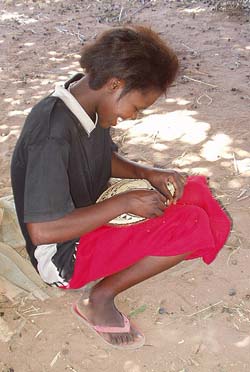 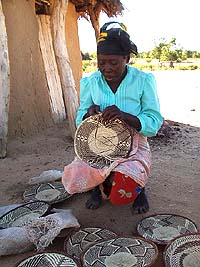 These baskets are from the Matabeleland
North region of Zimbabwe, which is an isolated region bordered
by the Zambezi River and Lake Kariba, and is at the bottom of
the Zambezi Encampment, which is the last crack of the Great
African Rift Valley. It is hot and arid, home of the tsetse fly,
and where I lived for 3 years back in the late seventies during
the war for black independence. These baskets are from the Matabeleland
North region of Zimbabwe, which is an isolated region bordered
by the Zambezi River and Lake Kariba, and is at the bottom of
the Zambezi Encampment, which is the last crack of the Great
African Rift Valley. It is hot and arid, home of the tsetse fly,
and where I lived for 3 years back in the late seventies during
the war for black independence.
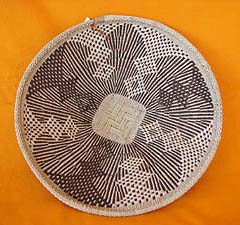
For many years these style baskets
were easy to find, as traders could easily go to the region and
ship the baskets to the U.S for sale. But ever since 2000, when
Mugabe, the President of Zimbabwe, began his slide into insanity
and his harsh land confiscation policies which have resulted
in Zimbabwe becoming the economic mess it is today, these baskets,
along with almost every other form of handmade art in Zimbabwe
have disappeared from the world’s markets. Part of the problem
is that living conditions are so harsh in Zimbabwe that no-one
has the time or energy to make them, there is no –one to
buy them, no petrol to drive into the region or drive out of
the region to deliver them to market, and so none were being
made. At least on a scale large enough that they would appear
in the U.S. markets.
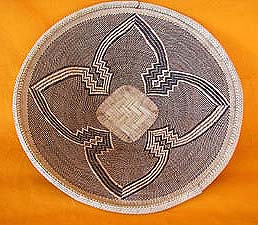 We
were fortunate enough to meet Wendy Blakely, an American living
in Zimbabwe and working for the Painted Dog Conservancy Project
in Dete, which is an area close to Victoria Falls and the Binga
region where the Batonka baskets are made. She is working with
local women in a co-op environment who produce hand made art
such as the baskets shown above, and is helping them market their
products by bringing them to the U.S. for sale. We were able
to purchase approximately one hundred such baskets, and are selling
then to our customers. Wendy is buying them directly from the
co-op, paying them cash. That cash will sustain each women and
her immediate family for at least a month, if not more. Each
sale is an immediate boost to the region, as the money will go
directly into the local economy for such purchases as food, clothing
and cleaning supplies such as disinfectant and/or medical supplies.
Each sale also confirms the need for more product and therefore
ensures that another basket will be made. We are excited to finally
have some of these museum quality baskets in our possession,
and hope that this means the Zimbabwean economy will finally
be recovering and the people in the region will survive. In case
you are interested, Zimbabwe is the only country in the world
where every citizen is a billionaire. They have the world’s
largest bank note - $10 billion. As you are probably realizing,
the money is worthless. The inflation rate is the highest in
the world – 20 million percent. We
were fortunate enough to meet Wendy Blakely, an American living
in Zimbabwe and working for the Painted Dog Conservancy Project
in Dete, which is an area close to Victoria Falls and the Binga
region where the Batonka baskets are made. She is working with
local women in a co-op environment who produce hand made art
such as the baskets shown above, and is helping them market their
products by bringing them to the U.S. for sale. We were able
to purchase approximately one hundred such baskets, and are selling
then to our customers. Wendy is buying them directly from the
co-op, paying them cash. That cash will sustain each women and
her immediate family for at least a month, if not more. Each
sale is an immediate boost to the region, as the money will go
directly into the local economy for such purchases as food, clothing
and cleaning supplies such as disinfectant and/or medical supplies.
Each sale also confirms the need for more product and therefore
ensures that another basket will be made. We are excited to finally
have some of these museum quality baskets in our possession,
and hope that this means the Zimbabwean economy will finally
be recovering and the people in the region will survive. In case
you are interested, Zimbabwe is the only country in the world
where every citizen is a billionaire. They have the world’s
largest bank note - $10 billion. As you are probably realizing,
the money is worthless. The inflation rate is the highest in
the world – 20 million percent.
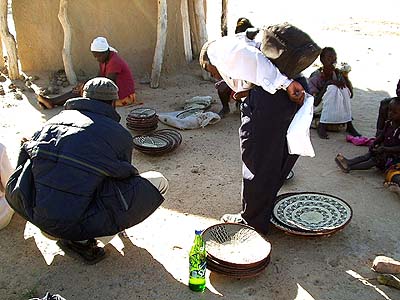 Another
Zimbabwean we met over the internet was Onasis Mutasa, a trader
who travels around Zimbabwe looking for art work to sell to the
U.S. He too has access to Batonka baskets, and possibly in the
future we will obtain some of his products for sale here. He
provided us with some pictures of his last trip to the Binga
region, with baskets in the process of being made. Another
Zimbabwean we met over the internet was Onasis Mutasa, a trader
who travels around Zimbabwe looking for art work to sell to the
U.S. He too has access to Batonka baskets, and possibly in the
future we will obtain some of his products for sale here. He
provided us with some pictures of his last trip to the Binga
region, with baskets in the process of being made.
Just to show you how arid and desolate
the region is, here are some pictures of the village where these
baskets are being made. The hut on raised stilts is a traditional
Batonka hut to keep wild animals and crocodiles away.
The average temperature here is 100
degrees, with not much rain. Mosquitos and Tsetse fly are rampant,
and there are no local stores nearby, with only one road in and
out of the area. It was paved in the late 1990’s.
As soon as Mugabe is gone, and Zimbabwe
returns to some normalcy J-Me and I plan on going back to Zimbabwe
and working with these people and co-ops in the region to promote
beadwork and handicrafts. I personally want to give back to an
area that has had everything taken away.
   |